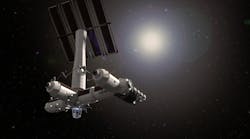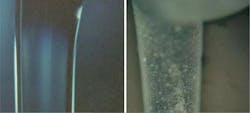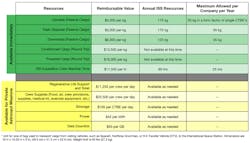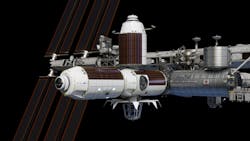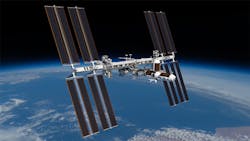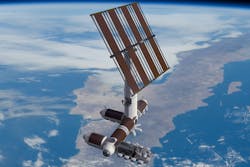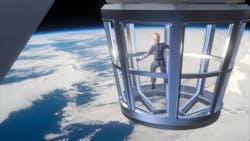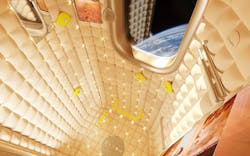The next logical step in humans’ exploration of space is to start having more civilian ventures—and commercial, money-making ones—in outer space. NASA is onboard with this step. It has made it a priority to seed and encourage a strong, bustling, and competitive low Earth orbit (LEO) economy with itself as a strong player and user of commercial services and equipment. To NASA, LEO ends at about 1,200 miles above Earth, but that’s where the International Space Station (ISS) orbits and it is relatively easy to get up into LEO and back.
LEO Economy
NASA’s five-point plan for setting up this LEO economy includes:
- Establishing a commercial use and pricing policy for the ISS that will reduce uncertainties for companies and let them devise business plans involving purely commercial activities, including marketing and tourism.
- Letting civilian astronauts of all nationalities onboard the ISS (for a price) as early as possible to train and carry out experiments and R&D, and setting up a process to assess and approve such missions.
- Codifying a process for developing commercial LEO destinations. As part of that goal, add a new docking module to the ISS to encourage more commercial flights to it.
- Investing in outside parties to explore and refine-space manufacturing and upgrading the ISS.
- Prioritizing NASA’s long-term need for programs that can be carried out in LEO. These include space life and physical-science research, determining the effects of space on humans, technology demonstrations, life cycle testing on equipment before deploying it to deeper space and in-flight crew training.
Accomplishing these goals should lay the groundwork for acquiring the know-how, equipment and experienced personnel that will be needed for future space programs, such as returning to the Moon and manned exploration of Mars. They also pave the way for the rest of NASA’s LEO initiative as outlined below.
NASA and other space experts have long touted space as the perfect place to carry out research into materials and manufacturing, except for the high price and potential dangers. They point to a list of advantages it presents engineer and scientists:
- Precise convection control.
- Elimination of sedimentation (due to microgravity).
- Diffusion lets otherwise “unmixable” materials to be intermixed.
- Material scientists can grow larger, higher-quality crystals.
- Near-absolute vacuum of space allows pure materials to be made and used.
- Isolated from vibrations.
- Vapor deposition can be conducted layer by layer without defects.
- Surface tension lets liquids form perfect spheres.
- Sunlight can be focused to beams hot enough to melt materials.
- Shaded exterior areas provide temperatures close to absolute zero.
- Precise temperature gradients can produce stronger materials.
Some of the space-made goods NASA and other experts envision include stronger, lighter alloys; glasses and porcelains with new capabilities; satellites; biomedical research compounds such as protein crystals, tissues and organs; and fiber optics.
For example, the microgravity of space lets fiber optics be manufactured cleaner and smother. On-orbit manufacture of ZBLAN fibers, a form of glass used for ultra-high throughput fiber optics, could be one of the initial mainstays of an LEO economy.
Other space experts point out that proteins grown in LEO expand in three dimensions to form nearly perfect crystals. These could provide healthcare researchers a new avenue for treatments related to allergic and inflammatory reactions, as well as muscular dystrophy.
Another source of income will likely involve testing exploration systems. As NASA and other entities begin planning missions outside of LEO, such as to the Moon or Mars, they will want to test the critical subsystems and components in space before sending them to places a lot harder to get to. It’s easier fixing equipment in LEO than if it is 250,000 miles away orbiting the Moon.
The ISS is almost the only game in town for companies and countries looking for space-based R&D labs and real-world astronaut training. And NASA seems ready to accommodate them, for a price. It recently published a price list for ISS access and service (below).
The prices are subject to change, but they are intended to give prospective purchasers an idea of what items and services will cost. The list could also spur other organizations to put similar space stations in orbit.
Axiom’s Addition
But space is limited on the ISS. To get around that limitation, NASA is partnering with Huston-based Axiom Space Inc. to add an extension on the space station.
The two entities are already closely collaborating, and Axiom’s leaders have a long history with NASA. Its co-founder and president/CEO, Michael Suffredini, served as NASA’s ISS program manager from 2005 to 2015 and oversaw the Station’s transition from assembly to operation and commercial use. The co-founder and executive chairman, Kam Ghaffarian, founded Stinger Ghaffarian Technologies, NASA’s second-largest engineering services contractor and the organization that trains NASA’s astronauts and operates the ISS.
Currently, Axiom is marketing three eight-day trips to the ISS for $55 million each. The voyage is planned for the second half of 2021. Axiom has contracted with SpaceX for a Crew Dragon rocket and capsules to take an Axiom-trained astronaut and the three passengers to and from the station.
The passengers will live onboard the ISS and “experience at least eight days of microgravity and views of the Earth that can only be appreciated in the large, venerable station,” according to Axiom statement from the company.
“This will be just the first of many missions to ISS to be completely crewed and managed by Axiom Space, a first for a commercial entity,” says Suffredini. Axiom plans on offering two similar trips per year in the future.
Axiom also has plans to build an ambitious $1.5 billion addition onto the ISS. To further those plans, it negotiated a firm-fixed price, indefinite-delivery, indefinite-quantity contract with NASA this past February. The contact’s maximum value is for a $140 million over a seven-year ordering period consisting of a five-year base period and a two-year option.
Axiom’s goal is have add at least three modules to the ISS, with the first scheduled to be taken up to the ISS by a SpaceX Falcon 9 launcher and bolted onto the space station in 2024. All of the modules should be in place by 2028.
It’s important to note that Axiom is not selling the new modules to NASA; it is retaining ownership and plans on use them to become a major player in the LEO economy. And it has a long-term vision.
Axiom knows the ISS was scheduled to retire in 2014. They also know NASA and its international partners in space have putatively decided to keep using the ISS until at least 2024 . It’s also likely they will push off retirement until 2028, the date space engineers predict the aging equipment onboard will have degraded to the point further use becomes too risky.
When ISS’s retirement comes, the Axiom modules will detach from the ISS and become Axiom Station, the first privately-owned free-flying space station. The company has a few other modules being planned that will be added after it is an established space station.
NASA likes the idea for several reasons. It gives more time for NASA to get as much use out of the $100 billion and help nurture its LEO initiative. It will also put an end to $3.5 billion NASA pays supporting the ISS, money it might rather spend on other missions. At the same time, it ensures there will still a space station in LEO doing commercial work and NASA programs for another 25 years.
Axiom says it can build its space station for $1.5 billion. The company intends to undercut ISS’ cost by using as much off the shelf, plug-and-play space technology and equipment as possible. The firm is also more streamlined with less red tape, and its experience provides insights on which requirements are valid and which are not.
The company also plans on making good use of much newer but proven advances in telecommunications and computing.
The station’s designers will take advantage of the lessons learned from the company’s involvement in the design, construction, and operation of the ISS. This, along with modern manufacturing; industrial-grade hardware; and electronics, controls and computers that are much smaller but much more powerful, will led to a station that is:
- Less-expensive to build
- Easier to maintain
- Ready to upgrade
The finished station will also have amenities such as high-speed Wi-Fi, video screens and windows.
The Modules
The modules will be made by Thales Alenia Space, the firm that has built much of the habitable modules on the ISS. When complete it will have:
- Pressurized research space.
- Unpressurized payload locations.
- Manufacturing facilities.
- Habitation modules with eight one-person crew quarters.
- The ability to support a crew of 16
- Cargo space (pressurized and unpressurized) equivalent to ISS.
- The largest space observatory.
- A crew-capable airlock.
The first module will attach to ISS’ Node 2 on the front (or at least one end) of the ISS. It will be a self-contained spaceship, complete with propulsion (and fuel), guidance, navigation and controls. There will also be accommodation for astronauts and space for research and manufacturing. Perhaps in a bid for tourists, it will also have an observatory pod emerging from one side with room enough for maybe two people that gives them a 360-deg. view of space. The windows are protected by a clamshell shield that can be retracted. Axiom calls it and a glass-walled cupola—which Axiom calls it “the largest window observatory ever constructed for the space environment.”
The second module, the living spaces, includes eight single-person “nest-like cabins” designed by Phillipe Starck, the well-known French industrial designer who founded Ubik. Each includes high-bandwidth communications with Earth, a small window (some with views of the Earth) and tufted, padded walls studded with color-changing LEDs.
The habitat module will contain environmental controls, a life support subsystem, a high-data-rate satcom suite, and a robotic arm for assembling Axiom Station and moving modules to reconfigure the station when needed. The robotics will most likely be Canadarm Two that Axiom astronauts will salvage from the ISS before it is abandoned.
The third module is for research and manufacturing spaces, and there will likely be several of these eventually.
The next module, which should be the installed just before Axiom Station is out its own, is the power mast. It holds the solar array which will be able to replace all the power the ISS could generate. It will also have the heat/cooling equipment necessary to maintain thermal control. In addition, there will also be an airlock to give the crew access to outer space.
Like NASA, Axiom plans on marketing access to space and time on the space station for both researchers and tourists, though details are not worked out. Axiom says, however, that it will provide all the training, planning, hardware, life support, medical support, crew provisions, safety certifications and on-orbit operations for travelers willing to take the jump into spaceflight.
For a look at how Axiom plans on putting its space station together, click here.
